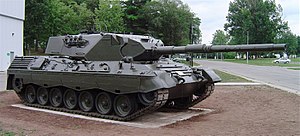Leopard 1
| Leopard 1 | |
|---|---|

Leopard 1A3 (Canadian Leopard C1) at the Base Borden Military Museum
|
|
| Type | Main battle tank |
| Place of origin | West Germany |
| Service history | |
| Wars | |
| Specifications | |
| Weight | 42.2 tonnes (increased on later models from original 40.0 tonnes) |
| Length | 9.54/8.29 m (gun forward/rearward) |
| Width | 3.37 m |
| Height | 2.39/2.70 m (turret roof/absolute) |
| Crew | 4 (commander, driver, gunner, radio operator/loader) |
|
|
|
| Armor | steel 19–21.7mm and 10–70 mm RHA |
|
Main
armament |
1 × 105 mm Royal Ordnance L7A3 L/52 rifled gun (13 rounds in turret 42 rounds in hull) |
|
Secondary
armament |
2 × 7.62 mm MG 3 or FN MAG (co-axial and commander's hatch) (5500 rounds) |
| Engine |
MTU MB 838 CaM 500, 10-cylinder, 37.4 litres, multi-fuel engine 830 PS (819 hp, 610 kW) at 2,200 RPM |
| Power/weight | 19.6 PS (14.5 kW) /tonne |
| Suspension | Torsion-bar |
|
Operational
range |
600 km (on road), 450 km (cross-country) |
| Speed | 65 km/h |
1 × 105 mm Royal Ordnance L7A3 L/52 rifled gun
The Leopard (or Leopard 1) is a main battle tank designed and produced in West Germany that first entered service in 1965. Developed in an era when HEAT warheads were thought to make conventional heavy armour of limited value, the Leopard focused on firepower in the form of the German-built version of the British L7 105-mm gun, and improved cross-country performance that was unmatched by other designs of the era.
The design started as a collaborative project during the 1950s between West Germany and France and later joined by Italy, but the partnership ended shortly after and the final design was ordered by the Bundeswehr, with full-scale production starting in 1965. In total, 6,485 Leopard tanks have been built, of which 4,744 were battle tanks and 1,741 were utility and anti-aircraft variants, not including 80 prototypes and pre-series vehicles.
The Leopard quickly became a standard of European forces, and eventually served as the main battle tank in over a dozen countries worldwide. Since 1990, the Leopard 1 has gradually been relegated to secondary roles in most armies. In the German Army, the Leopard 1 MBTs were phased out in 2003, while Leopard 1 derived vehicles are still widely used. The Leopard 2 MBTs have taken over the MBT role. Leopard hulls have been re-used in a wide variety of roles.
The Leopard project started in November 1956 in order to develop a modern tank, the Standard-Panzer, to replace the Bundeswehr's American-built M47 and M48 Patton tanks, which, though just delivered to West Germany's recently reconstituted army, were rapidly becoming outdated. On 25 July 1957, the detailed specifications were released; the new design needed to weigh no more than 30 metric tons, have a power-to-weight ratio of 30 horsepower per ton, be able to withstand hits by 20 mm rapid-fire guns on every side as well as to operate in a battlefield contaminated with chemical weapons or radioactive fallout, the then-standard baseline for combat with the Warsaw Pact. In addition, the main armament had to consist of a 105 mm caliber weapon (the new British L7A3 105 mm gun was selected), carrying at least as many rounds as current US tank designs. Mobility had priority, while firepower came second; armour was seen as less essential, as it was believed that no real protection against hollow charge weapons was possible anyway.
...
Wikipedia
